Use 'Print preview' to check the number of pages and printer settings.
Print functionality varies between browsers.
Printable page generated Friday, 28 November 2025, 4:01 PM
Study Session 3 Development and Sustainability
Introduction
The world’s population and economy are growing rapidly, resulting in an increasing demand for natural resources and increasing risk of environmental damage. Excessive use of natural resources such as water, land and forests affects the livelihoods of many people and national economies. Similarly, environmental damage can affect current and future economic and social development. In other words, the economy, society and the environment are interlinked issues. So, if you want to solve one of these problems you need to consider all three together, because addressing only one aspect either will not solve the problem in the long term, or it will create another problem. This is the concept of sustainability, which you are going to look at in this study session. We will also discuss different interpretations of development including economic, human and sustainable development and discuss the sustainability of WASH services.
Learning Outcomes for Study Session 3
When you have studied this session, you should be able to:
3.1 Define and use correctly each of the key words printed in bold. (SAQs 3.1 and 3.2)
3.2 Explain the difference between economic development and sustainable development. (SAQ 3.2)
3.3 Summarise the three pillars of sustainability. (SAQ 3.3)
3.4 Identify important factors for the sustainability of WASH services. (SAQ 3.4)
3.1 Economic growth, economic development and human development
You may have noticed that a lot of building work for new roads, schools and hospitals is taking place in Ethiopia (Figure 3.1). All these are the result of economic growth in the country, especially since the year 2000. You may think economic growth and economic development are the same thing and use the terms interchangeably, but they are not exactly the same.
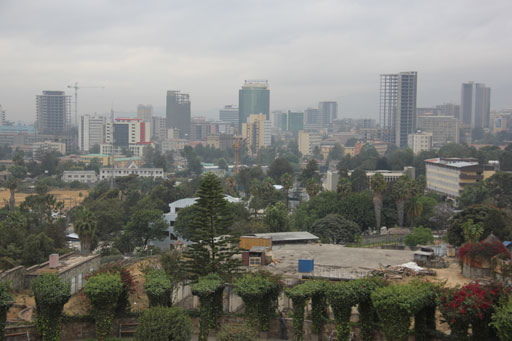
The economic growth of a country is an increase in worth of the national economy and is measured by its Gross Domestic Product (GDP). GDP is a measure of the total value of goods and services produced by a country in a year. It is usually measured in US dollars.
Economic development is a broader concept than economic growth that also includes aspects of human welfare. It is linked to technological and social progress, and general improvements in living standards. Economic development means improvements to infrastructure such as roads, schools, water and wastewater treatment plants, hydropower, etc. One of the indicators of economic development is GDP per capita. GDP per capita is the total GDP value divided by the population of the country, giving an indication of the economic output per head of population. This reflects an increase in the economic productivity and average material well-being of a country’s population but does not take account of uneven distribution of wealth among the population.
The GDP of India (US$2.05 trillion) is greater than the GDP of Norway (US$0.5 trillion) (IMF, 2015). So, can we say that India is more economically developed than Norway?
No. India has a higher total GDP than Norway, but it also has a much larger population. So, if you divide the GDP by the population to give GDP per capita, you would see that Norway has a much higher per capita GDP (US$97,013) than India (US$1,626). In reality, therefore, Norway is more economically developed than India.
GDP is a purely economic measure. Economic growth does not necessarily lead to human development. This is because a country can have an increase in GDP without improving the quality of life of the majority of people. Human developmentis the continuous improvement of human well-being and the quality of life. Some of the characteristics associated with countries that are not highly developed are a low literacy rate, high poverty level, high unemployment rate, high malnutrition, low water supply coverage, low health service coverage, poor roads, poor public transport and poor environmental conditions.
The most widely used indicator for human development is the Human Development Index (HDI), which measures the relative development status of different countries on a scale from 0 to 1. It looks beyond economic assessment and brings in other ways of measuring well-being. HDI is a composite index that focuses on three criteria:
- life expectancy
- education
- standard of living.
The first criterion, life expectancy, is the average number of years that a person may expect to live. If people live long and healthy lives, this will increase the HDI of a country. Ethiopia is one of the top six countries where life expectancy has increased the most in recent times, from 45 years in 1990 to 64 years in 2012 (WHO, 2014). This can be attributed to many factors such as better health services, increased safe water supplies and improved access to sanitation.
The second criterion in the HDI, education, comprises two components: years of schooling for the adult population, which is the average number of years of education received in a lifetime by people aged 25 years and older; and the expected years of schooling for children of school-entrance age.Developed countries are expected to have people in education for longer. Average years of education of adults in Ethiopia increased from 1.5 in 2000 to 2.2 in 2012, and expected years of schooling for children increased from 4.4 to 8.7 years over the same period (UNDP, 2013). This is because, since 1994, many schools have been built, teachers have been trained and emphasis has been placed on creating a child-friendly teaching and learning environment in schools (Figure 3.2). Alternative ways of providing basic education for children in remote areas have also been established, such as making the time of learning flexible (e.g. by letting the community decide the time of learning) and establishing mobile schools to reach disadvantaged groups and remote rural areas.
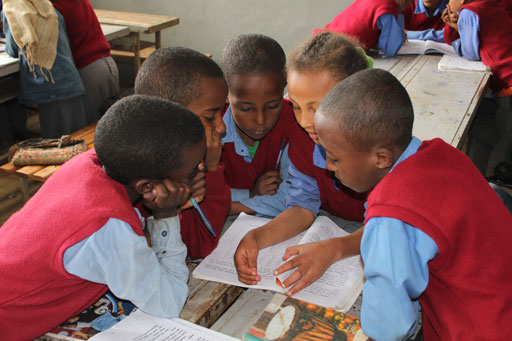
The final criterion in the HDI is standard of living, which means the level of wealth, comfort and material goods available to people. Ethiopia’s standard of living increased by more than 100% between 1985 and 2012 (UNDP, 2013). Despite this achievement, Ethiopia’s standard of living remains one of the lowest in the world.
The Human Development Index for Ethiopia is low. The value for 2012 was 0.396 which puts it in the category of ‘low human development’. The country is ranked 173rd out of 187 countries (UNDP, 2013). However, the situation has been improving as Ethiopia’s HDI increased by 32% in the 10 years to 2012 (UNDP, 2012) and an annual rate of increase of 3.1% places Ethiopia as the country with the third-fastest improving HDI in the world (MoFED, 2012a).
Ethiopia’s development progress can be seen by improvements in a range of areas:
- The poverty level in Ethiopia (defined as the percentage of the population below the national poverty line) declined from 38.7% in 2005 to 29.6% in 2012 (MoFED, 2006, 2012b).
- The adult literacy rate (defined as the percentage of the population age 15 and above who can, with understanding, read and write a short, simple statement on their everyday life) increased from 27% in 1994 to 36% in 2010/2011.
- Access to health facilities increased from 38% in 1991 to 89.6% in 2010 (Banteyerga et al., 2011).
- The total federal road network expanded more than threefold between 1997 and 2013, by which time it included 11,301 km of asphalt and 14,455 km of gravel road (Ethiopian Roads Authority, 2013).
Ethiopia is on track to achieve most of the Millennium Development Goals (MDGs). The MDGs are international development goals that were established following the Millennium Summit of the United Nations in 2000. UN Member States committed to achieve the MDGs by 2015. The goals were grouped into eight areas:
- Eradicate extreme poverty and hunger.
- Achieve universal primary education.
- Promote gender equality and empower women.
- Reduce child mortality.
- Improve maternal health.
- Combat HIV/AIDS, malaria and other diseases.
- Ensure environmental sustainability.
- Develop a global partnership for development.
Each of these goals had more specific targets associated with them. For example, Goal 7 had four targets, including one for improvements to water and sanitation. Target 7C was to ‘halve, by 2015, the proportion of the population without sustainable access to safe drinking water and basic sanitation’.
The 2014 report on MDG progress stated that Ethiopia was on track to achieve six out of the eight goals, i.e. all those except Goals 3 and 5 (NPC, 2015). For Goal 7, the picture is a little more complicated. Ethiopia successfully achieved the target for water supply but not for improvements to sanitation. Water supply coverage has increased and in March 2015 Ethiopia celebrated achieving the target of halving the number of people who were without access to safe water (Figure 3.3). Sanitation coverage has greatly improved, but with 37% of the population still using open defecation in 2012 (JMP, 2014) it has fallen short of the MDG target.
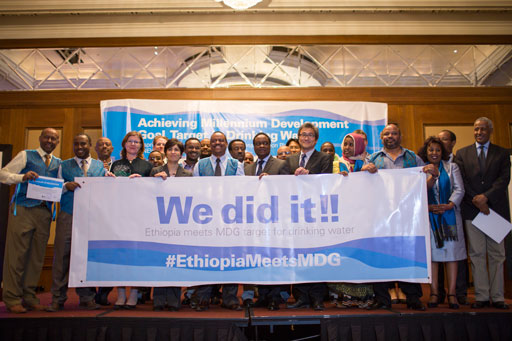
3.2 The Ethiopian economy
The Ethiopian economy has undergone rapid transformation since 2003/2004. GDP has grown at an average annual rate of 11% over the decade to 2012, making the country one of the fastest-growing in the world (UNDP, 2012). The poverty level in the country declined from 38.7% in 2005 to 29.6% in 2012 (WHO, 2014). The country has an ambitious plan to be a middle-income country by 2025.
In Ethiopia, agriculture has traditionally provided the biggest share of GDP, as the country is in the early stages of economic development. However, Figure 3.4 shows that agriculture’s share of GDP declined slightly from 2003/4 to 2008/9. This does not mean that the overall agricultural production decreased, but its contribution to the country’s overall GDP went down relative to other areas, particularly the service sector. The share of GDP earned by the service sector, such as retail, banks, hotels and real estate, grew rapidly over this time. The industrial sector makes up a smaller percentage of GDP and has remained relatively static at between 13% and 14%.
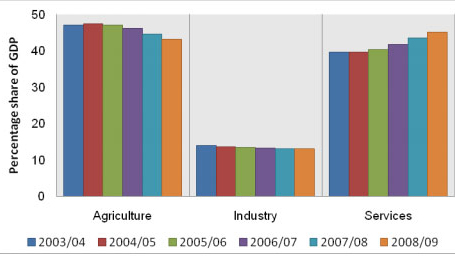
There are many factors that have driven Ethiopia’s rapid economic development, including:
- favourable weather conditions for agriculture in the past decade and an increase in land area under cultivation
- investment to improve schools, health facilities, roads, telecommunications and the energy sector
- diversification of exports from only a few commodities, such as coffee, to other commodities including oilseeds, flowers, animals and animal products
- increased remittances from Ethiopians living abroad
- increased tax revenue collection and more development aid from external donors
- government policies that focus on infrastructure development, commercialisation of agriculture and private sector development(Ncube et al., 2010).
Among the most relevant government policies is the Growth and Transformation Plan (GTP). This was introduced in 2010 to run for the five years up to 2015, coinciding with the timeframe of the Millennium Development Goals. It is followed with a second phase, GTP II. The GTP aims to improve the national economy and bring an end to poverty by increasing opportunities for commercial agriculture, large-scale industry and infrastructure development.
Do you think that Ethiopian economic growth (GDP increase) has translated to human development? What figures can you use to back up your answer?
Yes. To mention some figures, the HDI has increased by 32%; the poverty level declined from 38.7% in 2005 to 29.6% in 2012, and the country is on track to achieve six of the eight MDGs.
Despite the positive trends, Ethiopia’s economy is still vulnerable to climate-induced shocks (UNDP, 2012). Although the dominance of the agriculture sector is slowly declining (as shown in Figure 3.4), the country’s economy still depends on rain-fed agriculture. This means that if the rains fail the loss of crops can have disastrous results. To overcome these problems requires a more resilient economy; this will be discussed in Study Session 12.
3.3 Sustainable development
The idea that development can be measured purely in economic terms can be criticised because it does not take account of the impacts of economic growth on the environment and on society. Increasing awareness in the 20th century of the environmental degradation caused by human activities led to the idea of sustainable development. There are many different definitions of sustainable development, but the most commonly used is from the 1987 World Commission on Environment and Development Report. This report defined sustainable development as ‘development that meets the needs of the present without compromising the ability of future generations to meet their own needs’ (Brundtland, 1987).
What are the needs of the present and future generations? List at least three things that you think are basic needs for present and future generations.
There are many things that both the present and future generations need for their survival. You may have listed the following: clean air to breathe, clean water to drink, a clean environment, food, shelter and other natural resources that can be used to improve the quality of life.
If development improves only the lives of the present generation without taking future generations into consideration, it is not sustainable. For example, if a development extracted groundwater faster than it is replenished over the long term, it would cause groundwater depletion and thus affect the ability of future generations to meet their own water needs; it would not be sustainable.
The concept of sustainable development therefore incorporates human and economic development but adds another dimension by considering long-term consequences and environmental impacts as well. It means a system of development that allows current generations to develop economically and socially without passing on insoluble problems to future generations. To understand what this means in practice, we need to take a closer look at sustainability.
3.4 What is sustainability?
In general, sustainability can be defined as the ability of something to sustain itself or be sustained over time, but a more complete definition for our discussion is that sustainability is an approach that combines environmental, economic and social aspects to produce long-lasting development or prosperity. These three aspects – environmental, economic and social – are the pillars of sustainability (Figure 3.5).
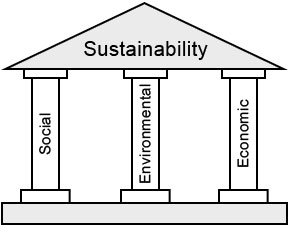
The economic pillar of sustainability is the efficient and responsible use of resources such as land, labour, capital and technology to create affordable goods and services with good value for money. The environmental pillar consists of implementing best practices that minimise the environmental impacts, such as using renewable energy to reduce the emission of greenhouse gases or minimising production of waste. The social pillar is about meeting the needs of all people or improving the quality of life for all members of society by better access to health care and education, and reducing poverty.
The central idea of sustainability is that all three pillars must be taken into consideration because without all three, the ‘building’ will collapse. For example, focusing only on economic growth without considering environmental impacts would not bring long-lasting profits if that growth depends on consumption of finite, non-renewable resources.
Name the non-renewable resources that humans use to provide energy.
You may have mentioned oil, coal, or gas.
Focusing on economic growth without addressing social problems such as poverty and unemployment will also be unsustainable. For example, when unemployment and poverty are very high, it means people do not have adequate money to meet their basic needs for food, shelter and clothing. This may lead to crime and unrest. If there are high crime levels and instability in a country, investors will be reluctant to invest and educated people may leave the country in search of a better life. The result is a negative impact on economic growth.
Similarly, just focusing on the environment may not ultimately protect it.Environmental sustainability needs both economic growth and social development, which may include changes in the structure of the economy and the way in which its benefits are distributed. For example, without opportunities for advancement, poor people will not have the options to use alternative energy sources and environmentally-friendly technologies so they are more likely to degrade the environment, for example, by cutting down trees for fuel.
3.5 Sustainability and WASH
If we want WASH projects to be sustainable, we need to consider the environmental and social aspects as well as the economic aspects. For example, WASH activities should not cause negative impacts to the environment; they should be economically feasible and financially sustainable, and they should be socially acceptable (i.e. consider the culture and value of the community).
Sustainability of WASH services such as hand pumps or communal latrines also relates to the very simple definition of sustainability that we started with, the ability of something to sustain itself or be sustained over time. WaterAid (2011) uses this definition:
Sustainability is about whether or not WASH services and good hygiene practices continue to work and deliver benefits over time. No time limit is set on those continued services, behaviour changes and outcomes. In other words, sustainability is about lasting benefits achieved through the continued enjoyment of water supply and sanitation services and hygiene practices.
The emphasis is clearly that the service must last a long time. There are a number of factors that contribute to the sustainability of WASH services. A WASH service is sustainable when (adapted from ACF International, 2007):
- it functions and is being used
- it is able to deliver an appropriate level of benefits (quality, quantity, convenience, comfort, continuity, affordability, efficiency, equity, reliability, health)
- it continues over a prolonged period of time and can be maintained and repaired to continue its life
- its management is institutionalised (community management, gender perspective, partnership with local authorities, involvement of formal/informal private sector)
- its operation and maintenance, administrative and replacement costs are covered at local level (through user fees, or alternative financial mechanisms)
- it can be operated and maintained at local level with limited but feasible, external support (technical assistance, training, monitoring)
- it does not affect the environment negatively.
Among the most important of these factors is the need for the service users to be fully involved in its planning, development and continuing maintenance, as the following case study demonstrates.
3.5.1 WASH case study
The sustainability of a WASH service is considered in Case Study 3.1. As you read it, think about the different pillars of sustainability and whether they are addressed here, and then answer the questions below.
Case Study 3.1 Jallele and the communal latrine
Jallele is a WASH practitioner at Kembebit Woreda Health Office, Oromia region. The woreda’s biggest market place is found in kebele 01 and the people who live in rural as well as urban areas of the woreda and nearby places gather twice a week on Wednesday and Saturday to buy and sell goods.
Jallele observed that open defecation was a common practice in kebele 01. In an effort to tackle the problem, she called for a meeting and held a discussion with the people/community living in the kebele. From this discussion, she found out that the people live in very congested conditions and they did not have land that they could spare for building individual household latrines.
During the discussion, the community suggested the construction of a communal latrine as a solution. Jallele discussed the situation with an NGO that is engaged in WASH and was able to convince them to allocate money for the construction of a communal latrine with eight seats. She told the community about the funding she had obtained and discussed the location of the latrine with the kebele administration. They identified an open access area near the market place and allocated this land for the construction. The justification they gave her was that this area was located at the centre of the community who did not have household latrines.
The latrine was built at the location the kebele administration identified. When the community started to use it Jallele was happy in her accomplishment. However, after some time, the latrine started to smell badly. The community stopped using it and went back to their old practice of open defecation. After a while, the latrine was totally abandoned as a result of the poor management. Besides, the bad smell started to affect the people who came to the market to buy and sell goods and they complained strongly about the construction of the latrine at this location.
Finally, Jallele introduced a follow-up system to address these problems. She encouraged the community to make a contribution to renovation of the existing latrine and to construct a new facility further away from the centre. She involved the community in the decision-making process and facilitated the setting up of an appropriate management system.
From Case Study 3.1, what do you think is the possible cause of the failure of the first project that Jallele implemented?
She didn't consider the financial sustainability or need for management. There was no money for maintaining, cleaning and managing the latrine. And she didn’t consider all social aspects. She hadn’t involved all members of the community in deciding where the latrine should be.
Which of the pillars of sustainability would you say that Jallele did consider when setting up the project?
She considered the environmental pillar and, to some extent, the social pillar. The latrine was set up to stop open defecation in order to improve the environment and people’s health. When she introduced the second plan she consulted the community and made sure they were involved in the process.
Summary of Study Session 3
In Study Session 3, you have learned that:
- Economic growth is concerned with Gross Domestic Product (GDP), while economic development refers to the distribution of the economy between different sectors and social groups and is linked with technological and social progress.
- Human development is concerned with reducing poverty and improving the quality of life. The most widely used indicator for human development is the Human Development Index (HDI) which is composed of three parts: life expectancy, education and standard of living.
- The Ethiopian economy has undergone rapid transformation since 2003/2004; because of this the poverty level in the country declined from 38.7% in 2005 to 29.6% in 2012.
- The Millennium Development Goals (MDGs) set international targets for development that included poverty reduction and improvements in health, education and environmental sustainability.
- Sustainable development considers the needs of the present without compromising the ability of future generations to meet their own needs.
- There are three pillars of sustainability: environmental, economic and social pillars. All three must be considered if sustainability is to be achieved.
- Sustainable WASH activities should not cause negative impacts on the environment; they should be economically feasible and financially sustainable and should also be socially acceptable.
Self-Assessment Questions (SAQs) for Study Session 3
Now that you have completed this study session, you can assess how well you have achieved its Learning Outcomes by answering these questions.
SAQ 3.1 (tests Learning Outcome 3.1)
Match the following words to their correct definitions.
Two lists follow, match one item from the first with one item from the second. Each item can only be matched once. There are 6 items in each list.
economic growth
Gross Domestic Product (GDP)
sustainability
sustainable development
economic development
human development
Match each of the previous list items with an item from the following list:
a.measured by Gross Domestic Product (GDP)
b.more than just measuring GDP; it also includes some aspects of technological and social progress
c.the total volume of goods and services produced by a country
d.meeting the needs of the present without compromising the ability of future generations to meet their own needs
e.an approach that considers environmental, economic and social aspects to produce long-lasting development or prosperity
f.continuous improvement in human well-being and quality of life
- 1 = a,
- 2 = c,
- 3 = e,
- 4 = d,
- 5 = b,
- 6 = f
SAQ 3.2 (tests Learning Outcomes 3.1 and 3.2)
You have a colleague who has difficulty in understanding the difference between economic development and sustainable development. How might you explain the difference between these two concepts?
Answer
You could start by saying that economic development is primarily concerned with income although it is more than just economic growth. Economic development means improving the living standards of people, for example by improvements in infrastructure, education and health systems as well as income. The central concept of sustainable development is that people’s lives can be improved without exhausting natural resources and without damaging the environment. In other words, it is about friendly coexistence between economic growth and the environment so that the needs of future generations can continue to be met.
SAQ 3.3 (tests Learning Outcome 3.3)
A friend has read in a newspaper article that in order for a society to thrive in the long term it must first address the three pillars of sustainability. Your friend asks you what these pillars represent and why they are considered important. Before answering, make a note of the three pillars and against each, list one or two key points you think your friend should know.
Answer
Your notes might have resembled the following:
Pillar 1: Economic sustainability
- Efficient and responsible use of land, labour, capital and technology.
- Good value for money
Pillar 2: Environmental sustainability
- Minimise damage and impact on the environment.
- Use renewable energy to limit environmental damage and climate change.
- Minimise waste
Pillar 3: Social sustainability
- Improve quality of life for the population.
- Reduce poverty.
SAQ 3.4 (tests Learning Outcome 3.4)
Imagine a project to install a new water or sanitation service for a community. What is wrong with each of the following statements?
- a.Developing a process for paying for future maintenance of the service is not important as long as the users were fully involved in the planning of the project and participated in decision making.
- b.WASH projects should be designed to meet the current needs of users so that financial costs can be minimised.
- c.When identifying the best location for the new installation, the only factor to consider is the wishes of the users.
Answer
- a.It is important to involve users in decision making but future financial sustainability is also important. The service is likely to fall into disrepair if maintenance cannot be paid for.
- b.Project design should take account of future needs as well as the current needs. Keeping costs down should not be the only criterion.
- c.Consulting with the users about their preferred location is important but other factors must also be considered including the potential environmental impacts and also the costs, which may differ between different possible locations.